

Проект «Голоса еврейских местечек. Могилевская область».פיתוח קשרי התרבות בין העמים של ישראל ובלרוס
|
|---|
Поиск по сайту |
|
MainNew publicationsContactsSite mapVitebsk regionMogilev regionMinsk regionIrina Bainova
|
THE HOLOCAUST IN SHKLOV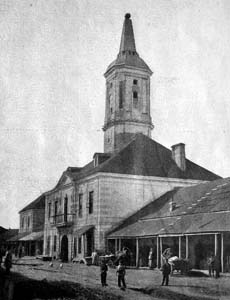
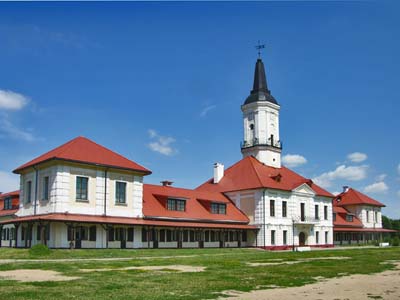 Town hall. Photos taken at the beginning of the 20th and 21st centuries.
Town hall. Photos taken at the beginning of the 20th and 21st centuries.
 View over Shklov from the Dnieper.
View over Shklov from the Dnieper.
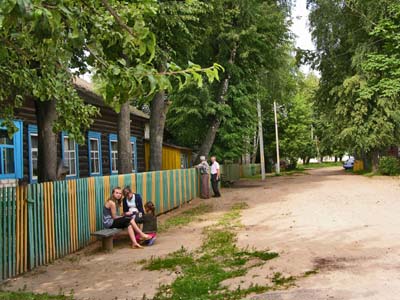
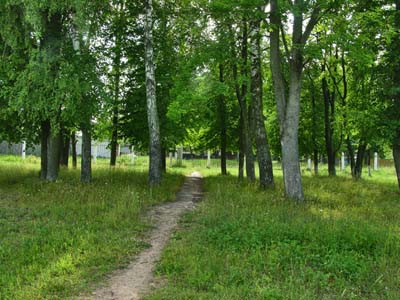 Linen factory. Lnozavodskaya street.
The linen factory – the former ghetto. The wooden building, where the Jews were kept, does not exist any longer. Only a path, which lead to the building, is still there.
Linen factory. Lnozavodskaya street.
The linen factory – the former ghetto. The wooden building, where the Jews were kept, does not exist any longer. Only a path, which lead to the building, is still there.
 On the territory of the linen factory
On the territory of the linen factorya memorial was set up to the factory workers, who died in the war. This regional center is located 30 km away from Mogilev. Jews came to Mogilev not earlier than the 20s of the 17th century. Shklov used to be one of the most significant centers of Jewish life in the Russian Empire. According to the stories of Shklov residents, evacuation started in the city only a day or two before it was invaded by Nazis. Before that any attempts to leave the city were considered as attempts of spreading the panic. People were not allowed to evacuate their families by train. Most of the Jews who were trying to leave, had to take horse carriages or walk. 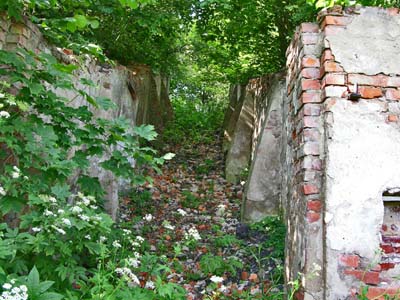 Entrance to the Jewish cemetery in Ryzhkovichi –
Entrance to the Jewish cemetery in Ryzhkovichi –the bodies of the victims were taken through it. 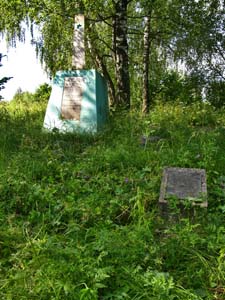
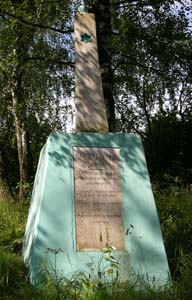 Memorial at the old Jewish cemetery in Shklov (Ryzhkovichi)
Memorial at the old Jewish cemetery in Shklov (Ryzhkovichi)at the re-burial site of the Jews from Shklov. 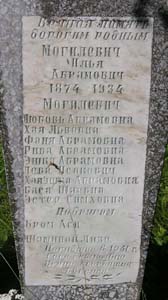 One of the individual burial
One of the individual burialsites at the Jewish cemetery. From July 12, 1941 to June 27, 1944 the city was occupied by Nazis, who killed 7504 people in Shklov and the outskirts (according to the official data) The Jews were moved to the Ghetto immediately after the occupation. There were several ghettos. More than 3000 people were sent to the territory of the linen factory (here they lived in destroyed houses and factory premises). The ghetto was guarded by the local residents. A curfew was declared – no one was allowed to go outside after 6 p.m. Jews had to wear yellow tabs on their clothes. In the neighboring village of Ryzhkovichi another ghetto was established with more than 2700 Jews. The ghetto was guarded by the local Nazi police. The ghetto exterminations continued for several months and began immediately after the occupation. Right after the occupation 25 Jews, men and women, were shot in a city park. One of the first extermination raids was organized in June, 1941. Nazis picked some men from the ghetto residents, aged from 15 to 65. They were told they would be sent somewhere to work (which was a typical tactic of the fascists: first men were murdered). All of the men were sent on a meadow on the right bank of the Dnieper (the number of the victims is unknown). 
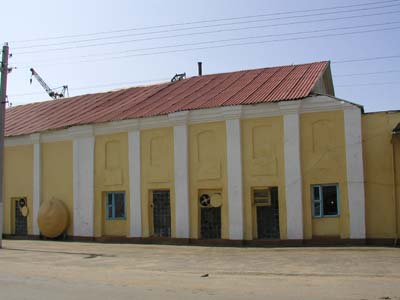 Synagogue. Photo taken at the beginning of the 20th century.
Former building of the synagogue, now a creamery.
Synagogue. Photo taken at the beginning of the 20th century.
Former building of the synagogue, now a creamery.
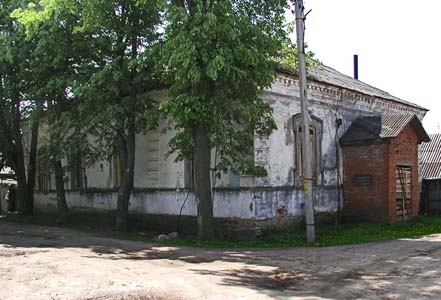
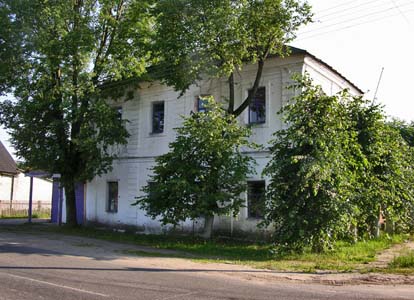
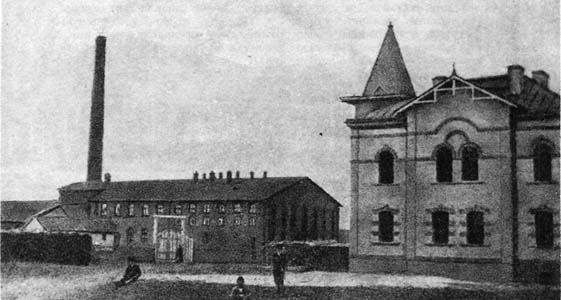 Building of a former prayer house (left).
Rabbi's house.
Paper factory. Photo taken at the beginning of the 20th century.
Building of a former prayer house (left).
Rabbi's house.
Paper factory. Photo taken at the beginning of the 20th century.
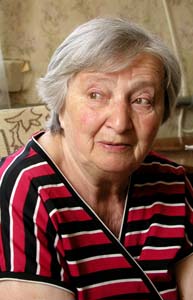 Asia Borisovna Tseitlina.
Asia Borisovna Tseitlina.
In the autumn and winter of 1941 the mass murders began. Next to Ryzhkovichi several groups of Jewish young men were executed (the number is unknown). 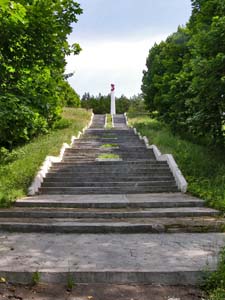 A symbolic memorial on the left bank of the Dnieper,
A symbolic memorial on the left bank of the Dnieper,not far away from the place of the execution. The memorial was erected in the 70s to all the residents of Shklov region, who were killed in World War II. In September 1941 every day Germans took groups of Jews to a ditch near Zarechie. There they were told to get undressed and shot. Many people were first tortured, beaten, stabbed with knives and then thrown into the ditch alive. The biggest ghetto extermination took place on October 2 or 3, 1941. According to the witnesses, many local residents were assembled and forced to watch the execution. That was a hint that such a fate would await everyone who would give shelter to the Jews. From the story told by Asia Borisovna Tseitlina «It was a day after Yom Kippur, October 3. A punitive squad with dogs arrived in the city. The Jews were forced out of their houses and taken to the village of Zarechie. All of them were then searched. I was walking across a field and saw all the people taken somewhere. I followed the big crowd. They were taken to the village of Putniki, where a ditch had been prepared. There everyone was shot. I could hear the shooting. There is no memorial on the grave today." From the archive of the project "The lessons of the Holocaust" Alexander Litin
|
|||
|
|
Jewish settlements in Mogilev regionMogilev• Antonovka• Batsevichi• Belynichi• Belynkovichi• Bobruisk• Byhov• Chausy• Cherikov• Dashkovka• Dribin• Esmony• Glusk• Golovchin• Gorki• Gory• Grozdianka• Hotimsk• Kirovsk• Klichev• Konohovka• Kostukovichi• Krichev• Krucha• Krugloye• Lenino• Lubonichi• Martinovka• Moliatichi• Mstislavl• Naprasnovka• Osipovichi• Rodnia• Rudkovschina• Samotevichi• Sapezhinka• Selets• Shamovo• Shepelevichi• Shklov• Slavgorod• Staroselie• Sukhari• Svisloch• Vereschaki• Zaverezhie• Zhilichi• |
Main |
New publications |
Contacts |
Site map |
Vitebsk region |
Mogilev region |
Minsk region |